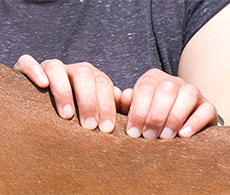
How to massage your horse
Massage has plenty of benefits, from improving circulation to helping your horse feel more comfortable. Massage therapist Cheryl Reed outlines the benefits and explains how to massage your horse
Meet the expert
Cheryl Reed, Dip. ICAT, IRVAP (MT), holds an Institute of Complementary Animal Therapies level five diploma in Equine Sports Massage and Rehabilitation, and is accredited with OCN London. She’s also a member of The Institute of Registered Veterinary & Animal Physiotherapists and is a LANTRA-qualified bridle and bit consultant. For further information, visit theathletichorse.co.uk.
Equine massage, often referred to as equine sports massage, is the hands-on therapeutic manipulation of muscles and tissues.
It brings a range of benefits for your horse because it:
- Promotes relaxation, both physically and mentally
- Increases flexibility, suppleness and a range of movement
- Improves posture
- Prevents injuries
- Reduces muscular pain and tension
- Improves joint mobility
- Stimulates circulation and cellular activity, and increases lymph flow
- Aids removal of metabolic waste products
- Mobilises fascia and breaks down knots and adhesions
- Uncovers areas of pain or soreness
- Warms up muscles for performance pre-exercise
- Aids recovery post exercise
- Assists in preventing muscle atrophy during periods of restricted exercise and relieves boredom
- Allows you to bond with your horse
Different types of massage application
There are several different methods used in a massage, which include:
- Stroking: this is a light pressure application, used for soothing and relaxing. It’s light enough so as not to disturb the structures beneath the skin. This method should be employed at the beginning and end of the massage.
- Effleurage: the most common massage application. Use the palm of one hand, or both hands, in a firm gliding action. The pressure can be light to deep to increase circulation and improve lymphatic drainage.
- Petrissage: this is a deeper, classic massage technique, performed with the fingertips, thumbs, forearm or even knuckles. It increases circulation and assists in freeing fascia and breaking up adhesions. It can involve kneading, compressions, muscle squeezing, picking-up, wringing and skin rolling.
- Tapotement: this consists of soft, rhythmical, bouncy blows with alternate hands, which stimulate nerves and muscle tissue. Cupping, pounding and hacking are all tapotement movements.
- Friction: pressure used over a small area, usually using your finger, supported by another finger, to break up muscle knots (adhesions) and to mobilise scar tissue.
- Vibration: a massage technique that helps to relax and soothe the body. This technique is used to reduce stress and tension, and improve circulation. It’s typically used at the end of a massage to help the body relax and recover.
How to massage your own horse
Whether you own a competition horse or enjoy hacking with your best friend, most horses will benefit from massage.
Here are some suggestions for you to try:
- Start with light, gentle strokes over your horse’s body, beginning at the top of the neck and working down over the shoulders and front legs, before moving your hands over their back and hindquarters. Continue down their hind legs. Assess for any injuries, tension or discomfort. This should take no more than two to three minutes.
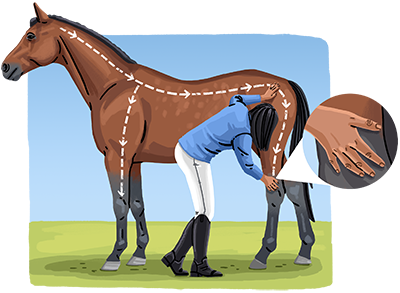
- Return to the poll and use effleurage strokes down the neck towards the shoulders. Use light, slow strokes with even pressure initially, before building more pressure. After a couple of minutes, move onto some circular petrissage strokes before finishing with sweeping effleurage strokes again.
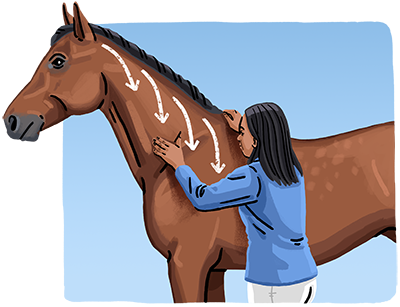
- At the shoulders, begin with effleurage and follow with some circular petrissage behind the withers. Work down behind the scapula towards the girth area. Horses can sometimes be sensitive around this area, especially if they’ve been wearing heavy rugs during the wintertime.
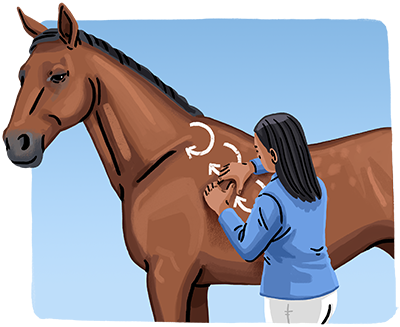
- Next, turn your attention to your horse’s back. Many ridden horses carry some degree of tension in this area. Begin with slow effleurage strokes along the length of the horse’s back. As you do this, your hand should be flat, with your fingers pointing in the direction of your horse’s tail. Repeat three to four times and then follow with some petrissage strokes for a few minutes. Continue with more effleurage strokes before moving onto the quarters.
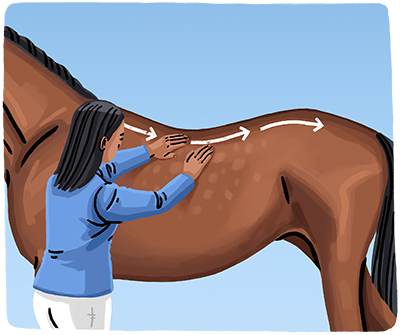
- Massage the large superficial gluteal muscles over your horse’s quarters. This is the horse’s powerhouse and you can apply more pressure here if the horse is happy for you to do so. After performing effleurage strokes, you could try other applications such as compressions and tapotement. But take care to judge your horse’s reaction. Work down over your horse’s hamstring muscles with more effleurage strokes.
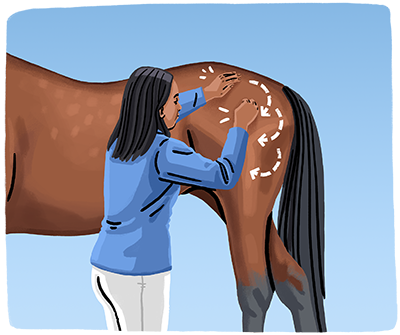
Important advice
- Be sure to avoid joints or bony areas and never massage over any wounds.
- It’s always important you’re careful to work within your horse’s comfort zone. Monitor their reactions to your touch. If your horse appears sore or shows any sign of muscle spasm, please consult a professional.
- The above guide isn’t a substitute for a visit from your regular equine therapist/bodyworker.
When to avoid massage
Sometimes, there are circumstances when you should NOT massage your horse. These are referred to as contraindications.
These include the following:
- Undiagnosed lameness
- If your horse has a temperature
- Any skin conditions (for example, ringworm or sunburn)
- Unhealed scar tissue or wounds
- Infectious diseases such as strangles or equine flu
- Colic or tying up
- Any area of acute trauma, swellings or heat (for example, acute hepatoma)
- Areas where there are tumours or sarcoids (massage may spread them)
- An exhausted or dehydrated horse or a horse in shock
- Pregnancy
If in any doubt, please seek professional advice.
Do you massage your horse? If so, head to our Facebook page and let us know using #PethoodStories.


